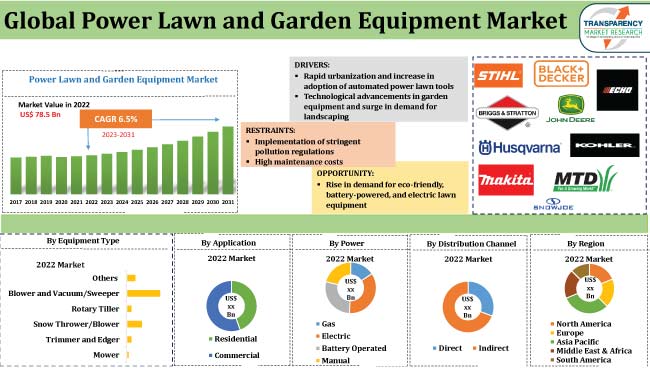Introduction
The Gardening Equipment Market refers to the global industry focused on producing and selling tools, machinery, and accessories designed for gardening and landscaping activities. Gardening equipment includes a broad range of products, from simple hand tools such as shovels, pruners, and rakes to more advanced machinery like lawnmowers, trimmers, hedge cutters, and leaf blowers. With the rise of urbanization and a growing interest in home gardening and landscaping, the demand for gardening tools has surged globally. This market caters to both casual gardeners as well as professional landscapers, providing solutions that help in maintaining both residential and commercial green spaces.
Market Size
Data Bridge Market Research analyses that the global gardening equipment market was valued USD 6.56 billion in 2022 and is expected to reach USD 14.16 billion by 2030, growing at a CAGR of 10.1 % during the forecast period of 2023 to 2030. In 2023, hand tools segment is expected to dominate the market due to the rise in trend of urban gardening and landscaping in residential and commercial projects in the developed and developing countries. In addition to the market insights such as market value, growth rate, market segments, geographical coverage, market players, and market scenario, the market report curated by the Data Bridge Market Research team includes in-depth expert analysis, import/export analysis, pricing analysis, production consumption analysis, and consumer behaviour.
For more information, visit https://www.databridgemarketresearch.com/reports/global-gardening-equipment-market
The popularity of do-it-yourself (DIY) gardening, spurred by the need for stress relief and the desire to create green spaces in increasingly urban environments, has contributed significantly to the rise in demand for gardening equipment. With gardening being recognized not only as a hobby but also as a means to enhance mental well-being, the market for gardening tools has expanded significantly in both developed and developing regions.
Market Share
Several key players dominate the Gardening Equipment Market, with established brands such as Husqvarna Group, MTD Products, Toro Company, Robert Bosch GmbH, and Stanley Black & Decker Inc. holding significant market share. These companies offer a wide range of gardening tools and machinery, known for their reliability, durability, and innovative technology. Their dominance is largely attributed to their vast product portfolios, strong brand presence, and extensive distribution networks across different regions.
In terms of regional market share, North America leads the Gardening Equipment Market, followed closely by Europe and the Asia-Pacific region. North America’s dominance can be attributed to the region’s strong consumer interest in home gardening and the high adoption of advanced garden tools. The U.S. in particular accounts for the largest share of the North American market, driven by high disposable incomes, widespread urban gardening initiatives, and the popularity of professional landscaping services.
Europe holds a significant share of the market, with countries like Germany, the U.K., and France being major contributors due to their robust horticultural and landscaping sectors. The Asia-Pacific region, on the other hand, is witnessing the fastest growth, with increasing urbanization, rising disposable incomes, and growing awareness of gardening and environmental sustainability driving the demand for gardening equipment in countries like China, India, and Japan.
The Evolution
The Gardening Equipment Market has evolved significantly over the years. What once started with simple hand tools has now grown into a market driven by technology, innovation, and sustainability. The evolution of gardening tools has been influenced by changing consumer preferences, advancements in technology, and the growing need for efficiency and convenience in gardening tasks.
In the past, manual tools such as hoes, shovels, and hand pruners were the primary tools used in gardening. However, with advancements in technology, powered tools and automated equipment have become more prevalent. The introduction of electric lawnmowers, battery-powered trimmers, and robotic lawn care systems has revolutionized the way consumers maintain their gardens, making it easier, faster, and more efficient.
The rise of smart gardening equipment has also marked a significant turning point in the industry. Smart irrigation systems, app-controlled lawnmowers, and AI-enabled plant sensors are increasingly becoming popular among tech-savvy consumers who seek convenience and precision in maintaining their gardens. These technological advancements not only improve gardening efficiency but also support water conservation efforts and promote sustainable gardening practices.
The demand for eco-friendly and sustainable gardening tools has also contributed to the evolution of the market. With growing concerns over climate change and environmental sustainability, consumers are looking for tools that reduce carbon emissions and minimize their environmental footprint. Manufacturers are responding by developing electric and battery-powered gardening tools that offer cleaner, quieter alternatives to traditional gas-powered machinery.
Market Trends
Several key trends are shaping the Gardening Equipment Market today. One of the most notable trends is the shift towards sustainable and eco-friendly gardening. As environmental awareness grows, consumers are increasingly adopting organic gardening practices and looking for tools and equipment that align with their eco-conscious values. This includes the use of battery-powered tools that reduce reliance on fossil fuels, as well as tools made from sustainable materials such as bamboo and recycled plastic.
The rise of urban gardening and small-space gardening is another significant trend. With more people living in apartments and smaller homes in urban areas, there is a growing demand for compact, space-efficient gardening tools designed for balcony gardens, rooftop gardens, and indoor plant cultivation. Vertical gardening, container gardening, and hydroponic gardening systems are becoming increasingly popular, driving demand for specialized tools that cater to these trends.
Technology continues to be a driving force in the evolution of the Gardening Equipment Market. The integration of smart technology into gardening tools is gaining traction, with consumers embracing innovations such as robotic lawnmowers, smart irrigation systems, and AI-powered plant monitoring devices. These smart tools offer convenience, efficiency, and the ability to automate routine gardening tasks, making them particularly appealing to tech-savvy gardeners and those with busy lifestyles.
The growing trend of DIY gardening and landscaping projects is also driving demand for gardening equipment. Many consumers, especially millennials, are taking a hands-on approach to gardening as a way to disconnect from digital life and reconnect with nature. This trend has led to increased sales of hand tools, DIY garden kits, and easy-to-use machinery that allows consumers to design and maintain their own green spaces.
Factors Driving Growth
Several factors are driving the growth of the Gardening Equipment Market. One of the primary drivers is the increasing awareness of the health and wellness benefits associated with gardening. Gardening has been shown to reduce stress, improve mental well-being, and promote physical activity, leading more people to take up gardening as a hobby. The COVID-19 pandemic further accelerated this trend, as people sought ways to spend time outdoors and engage in therapeutic activities during lockdowns.
Urbanization and the increasing trend of green spaces in cities have also fueled the demand for gardening equipment. As cities become more crowded, urban dwellers are turning to gardening as a way to bring nature into their homes and improve their quality of life. Urban gardening initiatives, community gardens, and the development of public parks and green spaces are all contributing to the rising demand for gardening tools and equipment.
Another significant factor driving the market is the rise in disposable income, particularly in emerging economies. As consumers in countries like China and India experience higher incomes and improved living standards, they are increasingly investing in home improvement projects, including gardening and landscaping. This has created new opportunities for manufacturers to expand their product offerings in these regions.
Technological advancements and innovation in product design are also contributing to market growth. The development of battery-powered, cordless, and robotic gardening tools has made gardening more accessible and convenient for consumers. These innovations not only improve the efficiency of gardening tasks but also cater to the growing demand for environmentally friendly and sustainable products.
Lastly, the expansion of e-commerce and online retail platforms has made gardening equipment more accessible to a broader audience. Consumers can now easily browse and purchase gardening tools online, benefiting from a wider selection of products, competitive pricing, and the convenience of home delivery. The rise of online gardening communities and influencers has also played a role in promoting gardening as a lifestyle choice, further boosting demand for gardening equipment.
Conclusion
The Gardening Equipment Market is poised for continued growth as more consumers embrace gardening as a way to enhance their living spaces, improve their health, and reconnect with nature. With a projected market size of USD 140 billion by 2027, the industry is evolving to meet the needs of modern gardeners through technological innovations, sustainable practices, and a focus on convenience and efficiency. Key trends such as the rise of urban gardening, smart gardening tools, and DIY landscaping projects are shaping the future of the market. Factors such as increasing disposable incomes, technological advancements, and growing environmental awareness are driving the demand for gardening equipment, positioning the market for sustained growth in the years to come.



